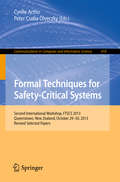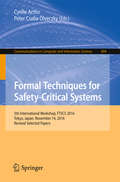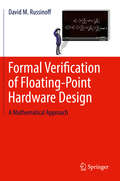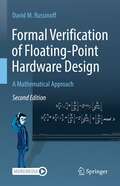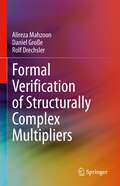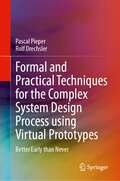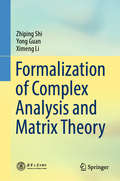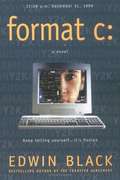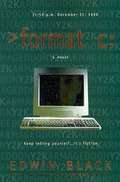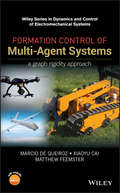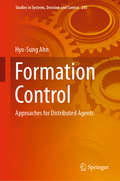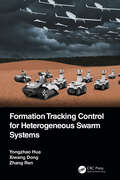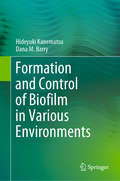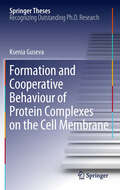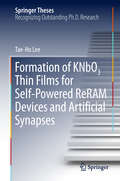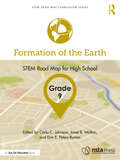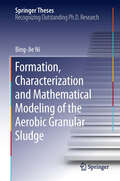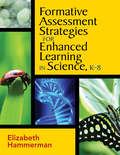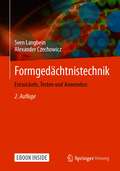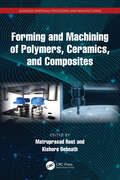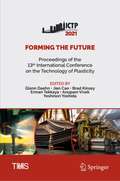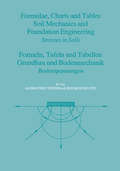- Table View
- List View
Formal Techniques for Safety-Critical Systems
by Cyrille Artho Peter Csaba ÖlveczkyThis book constitutes the refereed proceedings of the 4th International Workshop on Formal Techniques for Safety-Critical Systems, FTSCS 2015, held in Paris, France, in November 2015. The 15 revised full papers presented together with one invited talk and two tool papers were carefully reviewed and selected from 41 submissions. The papers are organized in topical sections on timed systems; railway systems; fault tolerance; automotive systems; software and systems analysis; tools.
Formal Techniques for Safety-Critical Systems
by Cyrille Artho Peter Csaba ÖlveczkyThis book constitutes the refereed proceedings of the Second International Workshop, FTSCS 2013, held in Queenstown, New Zealand, in October 2013. The 17 revised full papers presented together with an invited talk were carefully reviewed and selected from 32 submissions. The papers address various topics related to the application of formal and semi-formal methods to improve the quality of safety-critical computer systems.
Formal Verification of Floating-Point Hardware Design: A Mathematical Approach
by David M. Russinoff J Strother MooreThis is the first book to focus on the problem of ensuring the correctness of floating-point hardware designs through mathematical methods. Formal Verification of Floating-Point Hardware Design advances a verification methodology based on a unified theory of register-transfer logic and floating-point arithmetic that has been developed and applied to the formal verification of commercial floating-point units over the course of more than two decades, during which the author was employed by several major microprocessor design companies. The book consists of five parts, the first two of which present a rigorous exposition of the general theory based on the first principles of arithmetic. Part I covers bit vectors and the bit manipulation primitives, integer and fixed-point encodings, and bit-wise logical operations. Part II addresses the properties of floating-point numbers, the formats in which they are encoded as bit vectors, and the various modes of floating-point rounding. In Part III, the theory is extended to the analysis of several algorithms and optimization techniques that are commonly used in commercial implementations of elementary arithmetic operations. As a basis for the formal verification of such implementations, Part IV contains high-level specifications of correctness of the basic arithmetic instructions of several major industry-standard floating-point architectures, including all details pertaining to the handling of exceptional conditions. Part V illustrates the methodology, applying the preceding theory to the comprehensive verification of a state-of-the-art commercial floating-point unit. All of these results have been formalized in the logic of the ACL2 theorem prover and mechanically checked to ensure their correctness. They are presented here, however, in simple conventional mathematical notation. The book presupposes no familiarity with ACL2, logic design, or any mathematics beyond basic high school algebra. It will be of interest to verification engineers as well as arithmetic circuit designers who appreciate the value of a rigorous approach to their art, and is suitable as a graduate text in computer arithmetic.
Formal Verification of Floating-Point Hardware Design: A Mathematical Approach
by David M. RussinoffThis is the first book to focus on the problem of ensuring the correctness of floating-point hardware designs through mathematical methods. Formal Verification of Floating-Point Hardware Design, Second Edition advances a verification methodology based on a unified theory of register-transfer logic and floating-point arithmetic that has been developed and applied to the formal verification of commercial floating-point units over the course of more than two decades, during which the author was employed by several major microprocessor design companies. The theory is extended to the analysis of several algorithms and optimization techniques that are commonly used in commercial implementations of elementary arithmetic operations. As a basis for the formal verification of such implementations, high-level specifications of the basic arithmetic instructions of several major industry-standard floating-point architectures are presented, including all details pertaining to the handling of exceptional conditions. The methodology is illustrated in the comprehensive verification of a variety of state-of-the-art commercial floating-point designs developed by Arm Holdings. This revised edition reflects the evolving microarchitectures and increasing sophistication of Arm processors, and the variation in the design goals of execution speed, hardware area requirements, and power consumption. Many new results have been added to Parts I—III (Register-Transfer Logic, Floating-Point Arithmetic, and Implementation of Elementary Operations), extending the theory and describing new techniques. These were derived as required in the verification of the new RTL designs described in Part V.
Formal Verification of Structurally Complex Multipliers
by Rolf Drechsler Daniel Große Alireza MahzoonThis book addresses the challenging tasks of verifying and debugging structurally complex multipliers. In the area of verification, the authors first investigate the challenges of Symbolic Computer Algebra (SCA)-based verification, when it comes to proving the correctness of multipliers. They then describe three techniques to improve and extend SCA: vanishing monomials removal, reverse engineering, and dynamic backward rewriting. This enables readers to verify a wide variety of multipliers, including highly complex and optimized industrial benchmarks. The authors also describe a complete debugging flow, including bug localization and fixing, to find the location of bugs in structurally complex multipliers and make corrections.
Formal and Practical Techniques for the Complex System Design Process using Virtual Prototypes: Better Early than Never
by Rolf Drechsler Pascal PieperThis book deals with formal and practical approaches for early fast modeling and verification of complex digital processor hardware and software using SystemC-based virtual prototypes. As a special focus, modeling approaches of instruction-level behavior of System-on-Chips and the connected off-chip digital devices are addressed. Featured verification approaches are based on symbolic execution of simulated hardware devices or on classical discrete execution of the whole system with dynamic data flow tracking. The approaches are accompanied by Case-Studies that develop and build on top of an open-source RISC-V SoC simulation.In Particular, this book:
Formalization of Complex Analysis and Matrix Theory
by Yong Guan Zhiping Shi Ximeng LiThis book discusses the formalization of mathematical theories centering on complex analysis and matrix theory, covering topics such as algebraic systems, complex numbers, gauge integration, the Fourier transformation and its discrete counterpart, matrices and their transformation, inner product spaces, and function matrices. The formalization is performed using the interactive theorem prover HOL4, chiefly developed at the University of Cambridge. Many of the developments presented are now integral parts of the library of this prover.As mathematical developments continue to gain in complexity, sometimes demanding proofs of enormous sizes, formalization has proven to be invaluable in terms of obtaining real confidence in their correctness. This book provides a basis for the computer-aided verification of engineering systems constructed using the principles of complex analysis and matrix theory, as well as building blocks for the formalization of more involved mathematical theories.
Format C:
by Edwin BlackTwo Millennial fears haunted most Americans at the tunr of the last century: the sense of Armageddon, and the pending Y2K crisis. Both are woven together in Edwin Black's Format C:, a tense and compelling mystic techno-thriller about the final battle between good and evil fought against the race to fix the Millennium Bug.
Format C:
by Edwin BlackBlack weaves together two millennial fears--the sense of Armageddon, and the impending Y2K crisis--into a tense and compelling, mystic techno-thriller about the final battle between good and evil fought during the race to fix the Millennium Bug.
Formation Control of Multi-Agent Systems: A Graph Rigidity Approach (Wiley Series in Dynamics and Control of Electromechanical Systems)
by Marcio De Queiroz Xiaoyu Cai Matthew FeemsterFormation Control of Multi-Agent Systems: A Graph Rigidity Approach Marcio de Queiroz, Louisiana State University, USA Xiaoyu Cai, FARO Technologies, USA Matthew Feemster, U.S. Naval Academy, USA A comprehensive guide to formation control of multi-agent systems using rigid graph theory This book is the first to provide a comprehensive and unified treatment of the subject of graph rigidity-based formation control of multi-agent systems. Such systems are relevant to a variety of emerging engineering applications, including unmanned robotic vehicles and mobile sensor networks. Graph theory, and rigid graphs in particular, provides a natural tool for describing the multi-agent formation shape as well as the inter-agent sensing, communication, and control topology. Beginning with an introduction to rigid graph theory, the contents of the book are organized by the agent dynamic model (single integrator, double integrator, and mechanical dynamics) and by the type of formation problem (formation acquisition, formation manoeuvring, and target interception). The book presents the material in ascending level of difficulty and in a self-contained manner; thus, facilitating reader understanding. Key features: Uses the concept of graph rigidity as the basis for describing the multi-agent formation geometry and solving formation control problems. Considers different agent models and formation control problems. Control designs throughout the book progressively build upon each other. Provides a primer on rigid graph theory. Combines theory, computer simulations, and experimental results. Formation Control of Multi-Agent Systems: A Graph Rigidity Approach is targeted at researchers and graduate students in the areas of control systems and robotics. Prerequisite knowledge includes linear algebra, matrix theory, control systems, and nonlinear systems.
Formation Control: Approaches for Distributed Agents (Studies in Systems, Decision and Control #205)
by Hyo-Sung AhnThis monograph introduces recent developments in formation control of distributed-agent systems. Eschewing the traditional concern with the dynamic characteristics of individual agents, the book proposes a treatment that studies the formation control problem in terms of interactions among agents including factors such as sensing topology, communication and actuation topologies, and computations. Keeping pace with recent technological advancements in control, communications, sensing and computation that have begun to bring the applications of distributed-systems theory out of the industrial sphere and into that of day-to-day life, this monograph provides distributed control algorithms for a group of agents that may behave together. Unlike traditional control laws that usually require measurements with respect to a global coordinate frame and communications between a centralized operation center and agents, this book provides control laws that require only relative measurements and communications between agents without interaction with a centralized operator. Since the control algorithms presented in this book do not require any global sensing and any information exchanges with a centralized operation center, they can be realized in a fully distributed way, which significantly reduces the operation and implementation costs of a group of agents. Formation Control will give both students and researchers interested in pursuing this field a good grounding on which to base their work.
Formation Mechanism and Control Strategies of Haze in China (Advanced Topics in Science and Technology in China #66)
by Jianguo Liu Hong He Xinming Wang Yuesi Wang Zifa Wang Yunfa ChenThis book summarizes the new major research findings about formation mechanism and control strategies of haze in China, including basic theories, key technologies, equipment and platforms and the applications and implementations of control technologies, in implementing the Strategic Priority Research Program (Class B) of Chinese Academy of Sciences. Different types of air pollution processes experienced by the developed countries in different stages are out-breaking simultaneously in China in the recent years and resulting a new type of “haze chemistry smog” pollution, which is different from the “London smog” and the “Los Angeles photochemical smog”. This book provides a useful reference for related researchers, engineers and policy-makers engaged in atmospheric pollution research, prevention and control in China and other countries.
Formation Tracking Control for Heterogeneous Swarm Systems
by Xiwang Dong Yongzhao Hua Zhang RenSwarm system, also known as multi-agent system, refers to a system composed of multiple subsystems (agents) with certain communication, calculation, decision-making, and action capabilities through local information interaction, such as a group of unmanned aerial vehicles (UAVs), unmanned ground vehicles (UGVs), satellites, etc. Formation tracking control of swarm systems is an important technical support and approach for the emergence of swarm intelligence at motion control level. By applying formation tracking control, swarm system agents can adjust their relations in the state or output space through neighboring information interaction, and then the swarm system can achieve favorable space-time conditions for many cooperative tasks such as source seeking, target enclosing, and surveillance. Thus, complex missions can be performed efficiently or cost-effectively. In cross-domain collaborative applications, including air-ground coordination and air-sea coordination, swarm systems are usually composed of several heterogeneous agents, and swarm intelligence can be enhanced by complementary functions of different agents. How to achieve time-varying formation tracking for heterogeneous swarm systems is crucial for cross-domain coordination, which has important theoretical value and practical significance. This important book presents a systematic theoretical approach and control framework on the time-varying formation tracking for high-order heterogeneous swarm systems. Distributed controller design and stability analysis of closed-loop systems for several specific formation tracking problems are provided. Furthermore, the proposed control approaches are applied to practical cooperative experiment platforms composed of UAVs and UGVs, and several formation tracking experiments are carried out to further verify the effectiveness of the theories.
Formation and Control of Biofilm in Various Environments
by Hideyuki Kanematsu Dana M. BarryThis book provides excellent techniques for detecting and evaluating biofilms: sticky films on materials that are formed by bacterial activity and produce a range of industrial and medical problems such as corrosion, sanitary problems, and infections. Accordingly, it is essential to control biofilms and to establish appropriate countermeasures, from both industrial and medical viewpoints. This book offers valuable, detailed information on these countermeasures. It also discusses the fundamentals of biofilms, relates various substrates to biofilms, and presents a variety of biofilm reactors. However, the most important feature of this book (unlike others on the market) is its clear focus on addressing the practical aspects from an engineering viewpoint. Therefore, it offers an excellent practical guide for engineers and researchers in various fields, and can also be used as a great academic textbook.
Formation and Cooperative Behaviour of Protein Complexes on the Cell Membrane
by Ksenia GusevaWith the aim of providing a deeper insight into possible mechanisms of biological self-organization, this thesis presents new approaches to describe the process of self-assembly and the impact of spatial organization on the function of membrane proteins, from a statistical physics point of view. It focuses on three important scenarios: the assembly of membrane proteins, the collective response of mechanosensitive channels and the function of the twin arginine translocation (Tat) system. Using methods from equilibrium and non-equilibrium statistical mechanics, general conclusions were drawn that demonstrate the importance of the protein-protein interactions. Namely, in the first part a general aggregation dynamics model is formulated, and used to show that fragmentation crucially affects the efficiency of the self-assembly process of proteins. In the second part, by mapping the membrane-mediated forces into a simplified many-body system, the dynamic and equilibrium behaviour of interacting mechanosensitive channels is derived, showing that protein agglomeration strongly impacts its desired function. The final part develops a model that incorporates both the agglomeration and transport function of the Tat system, thereby providing a comprehensive description of this self-organizing process.
Formation and Temperature Stability of the Liquid Phase in Thin-Film Systems
by Serhii Dukarov Serhii Petrushenko Sergiy Bogatyrenko Vladimir SukhovThis book presents a summary of the topic of supercooling during crystallization in condensed films. While recent findings are mainly published in English, the foundational classical results were originally published in Russian, with limited accessibility to general readers. The present work is based on a 2019 Ukrainian monograph, "Temperature Stability of the Supercooled Liquid Phase in Condensed Films," which has been extensively revised and expanded.The book includes a detailed analysis of the thermodynamics of supercooled fluids, with updated and expanded sections. Additionally, new results on the supercooling of indium-lead (In-Pb) alloys in contact with amorphous molybdenum and fusible metals in contact with nanocrystalline layers are presented. These layers occupy a middle ground between amorphous (carbon, molybdenum, as-deposited germanium films) and polycrystalline (copper, silver, aluminum) substrates. The book gives particular attention to the peculiarities of contracted geometry conditions, which are natural for multilayered structures and can occur through fusible component segregation at grain boundaries.The analysis of new data has prompted a rethinking of the role of the more refractory layer's microstructure on the crystallization processes of metastable melts. The book includes a thorough discussion of these findings, highlighting the crucial role of the microstructure in the crystallization process. This book is a valuable resource for researchers and students interested in crystallization in thin-film metallic systems. This comprehensive study provides a detailed and authoritative analysis of the thermodynamics of supercooled fluids, and the impact of microstructure on the crystallization processes of metastable melts, making it an essential addition to any academic library.
Formation of KNbO3 Thin Films for Self-Powered ReRAM Devices and Artificial Synapses (Springer Theses)
by Tae-Ho LeeThis thesis describes an investigation into homogeneous KN crystalline films grown on Pt/Ti/SiO2/Si substrates, amorphous KN films grown on TiN/Si substrates using the RF-sputtering method, and the ferroelectic and piezoelectric properties of these KN films. KNbO3 (KN) thin films have been extensively investigated for applications in nonlinear optical, electro-optical and piezoelectric devices. However, the electrical properties of KN films have not yet been reported, because it is difficult to grow stoichiometric KN thin films due to K2O evaporation during growth. This thesis also reports on the ReRAM properties of a biocompatible KN ReRAM memristor powered by the KN nanogenerator, and finally shows the biological synaptic properties of the KN memristor for application to the artificial synapse of a neuromorphic computing system.
Formation of the Earth, Grade 9: STEM Road Map for High School (STEM Road Map Curriculum Series)
by Carla C. Johnson Erin E. Peters-Burton Janet B. WaltonWhat if you could challenge your ninth graders to use geologic theory and standards of measurement to explore different epochs and time periods of the Earth’s formation? With this volume in the STEM Road Map Curriculum Series, you can! Formation of the Earth outlines a journey that will steer your students toward authentic problem solving while grounding them in integrated STEM disciplines. Like the other volumes in the series, this book is designed to meet the growing need to infuse real-world learning into K–12 classrooms. This interdisciplinary, three-lesson module uses project- and problem-based learning to help students investigate how Earth science professionals gather information and develop theories about the formation of the Earth and the processes taking place since the proliferation of humans. Working in teams, students will work to identify, define and describe the attributes scientists use to delineate Earth’s eras, periods, and epochs, in order to determine the appropriate boundary event to define the Anthropocene Epoch, and will develop a publication-ready textbook entry for an Earth science textbook. To support this goal, students will do the following: • Identify, define, and describe attributes of eras, periods, and epochs which have marked geologic time in Earth’s history. • Evaluate various possible index layers and boundary events that mark the beginning of the Anthropocene Epoch to determine which is most appropriate when labeling the current epoch in Earth’s history. • Design and present a multimedia presentation to share with textbook publishers regarding information on the Anthropocene Epoch, to include in a secondary-level Earth science textbook. • Create a publication-ready textbook entry describing the Anthropocene Epoch. The STEM Road Map Curriculum Series is anchored in the Next Generation Science Standards, the Common Core State Standards, and the Framework for 21st Century Learning. In-depth and flexible, Formation of the Earth can be used as a whole unit or in part to meet the needs of districts, schools, and teachers who are charting a course toward an integrated STEM approach.
Formation, characterization and mathematical modeling of the aerobic granular sludge
by Bing-Jie NiAerobic granular sludge technology will play an important role as an innovative technology alternative to the present activated sludge process in industrial and municipal wastewater treatment in the near future. Intended to fill the gaps in the studies of aerobic granular sludge, this thesis comprehensively investigates the formation, characterization and mathematical modeling of aerobic granular sludge, through integrating the process engineering tools and advanced molecular microbiology. The research results of this thesis contributed significantly to the advance of understanding and optimization of the bacterial granulation processes, the next generation of technology for cost-effective biological wastewater treatment. Dr. Bing-Jie Ni works at Advanced Water Management Centre (AWMC) of The University of Queensland, Australia.
Formative Assessment Strategies for Enhanced Learning in Science, K-8
by Elizabeth HammermanUse formative assessment to guide successful teaching and learning in science! Outlining the formative assessment process and providing strategies for embedding assessment into the K–8 standards-based science curriculum, this essential resource demonstrates how teachers can use formative assessments to modify instruction, monitor student progress, and evaluate learning. This user-friendly guide offers teachers discussions, reflection activities, and classroom strategies to: Assess student understanding using observation checklists, questioning strategies, notebooks, reports, graphic organizers, projects, and performance tasks Differentiate science instruction to reach all learners Use rubrics to uncover student strengths and weaknesses Collect student data to inform instructional decisions
Formgedächtnistechnik: Entwickeln, Testen und Anwenden
by Alexander Czechowicz Sven LangbeinTrotz der technischen Vorteile von Formgedächtnislegierungen (FGL) gegenüber den auf dem Markt befindlichen Lösungen, lässt der Durchbruch dieser Technologie noch immer auf sich warten. Dies liegt vor allem am mangelnden Konstruktionswissen bei industriellen Anwendern. Dieser Problematik soll dieses Buch mit Konstruktionsrichtlinien und Produktentwicklungsmethoden entgegentreten. Es werden von den Grundlagen über Auslegungsmethodiken bis hin zu Steuer- und Regelkreisen alle für den Produktentwickler wichtigen Aspekte beschrieben.
Forming and Machining of Polymers, Ceramics, and Composites (Advanced Materials Processing and Manufacturing)
by Kishore Debnath Matruprasad RoutForming and Machining of Polymers, Ceramics, and Composites targets the two important manufacturing processes where plastic deformation is involved to give the required shape and size to the raw material. The main goal of the book is to represent the recent developments in the field of forming and machining of different non-metals, especially polymers, composites, and ceramics. Special focus is on the advancement of these processes to manufacture components from these non-metals. Presents exclusive material dedicated to forming and machining of non-metals, that is, polymers, ceramics, and composites Provides comprehensive coverage of all important topics related to non-metals processing Covers basics and current research in the field of forming and machining of non-metals Focuses on sustainability interventions and intelligent manufacturing techniques for quality and productivity in forming and machining of non-metals Discusses conventional and non-conventional machining and microfabrication aspects for fabrication and processing of non-metals This book is aimed at graduate students and researchers in materials processing and machine design.
Forming the Future: Proceedings of the 13th International Conference on the Technology of Plasticity (The Minerals, Metals & Materials Series)
by Jian Cao Glenn Daehn Brad Kinsey Erman Tekkaya Anupam Vivek Yoshinori YoshidaIn this collection, scientists and engineers from across industry, academia, and government present their latest improvements and innovations in all aspects of metal forming science and technology, with the intent of facilitating linkages and collaborations among these groups. Chapters cover the breadth of metal forming topics, from fundamental science to industrial application.
Forms and Concepts for Lightweight Structures
by Koryo Miura Sergio PellegrinoCovering a wide range of structural concepts and presenting both relevant theories and their applications to actual structures, this book brings together for the first time lightweight structures concepts for many different applications and the relevant scientific literature, thus providing unique insights into a fascinating field of human endeavour. Evolved from a series of graduate courses taught by the authors at the University of Tokyo, the Institute of Space and Astronautical Science, the University of Cambridge and the California Institute of Technology, this textbook provides both theoretical and practical insights and presents a range of examples which also provide a history of key lightweight structures since the Apollo age. This essential guide will inspire the imagination of engineers and provide an analytical foundation for all readers.
Formulae, Charts and Tables in the Area of Soil Mechanics and Foundation Engineering
by Edgar Schultze Alemayehu TeferraA gathering of useful data in tabular/chart form with examples to demonstrate the use of the information. No indices. Annotation copyright Book News, Inc. Portland, Or.
